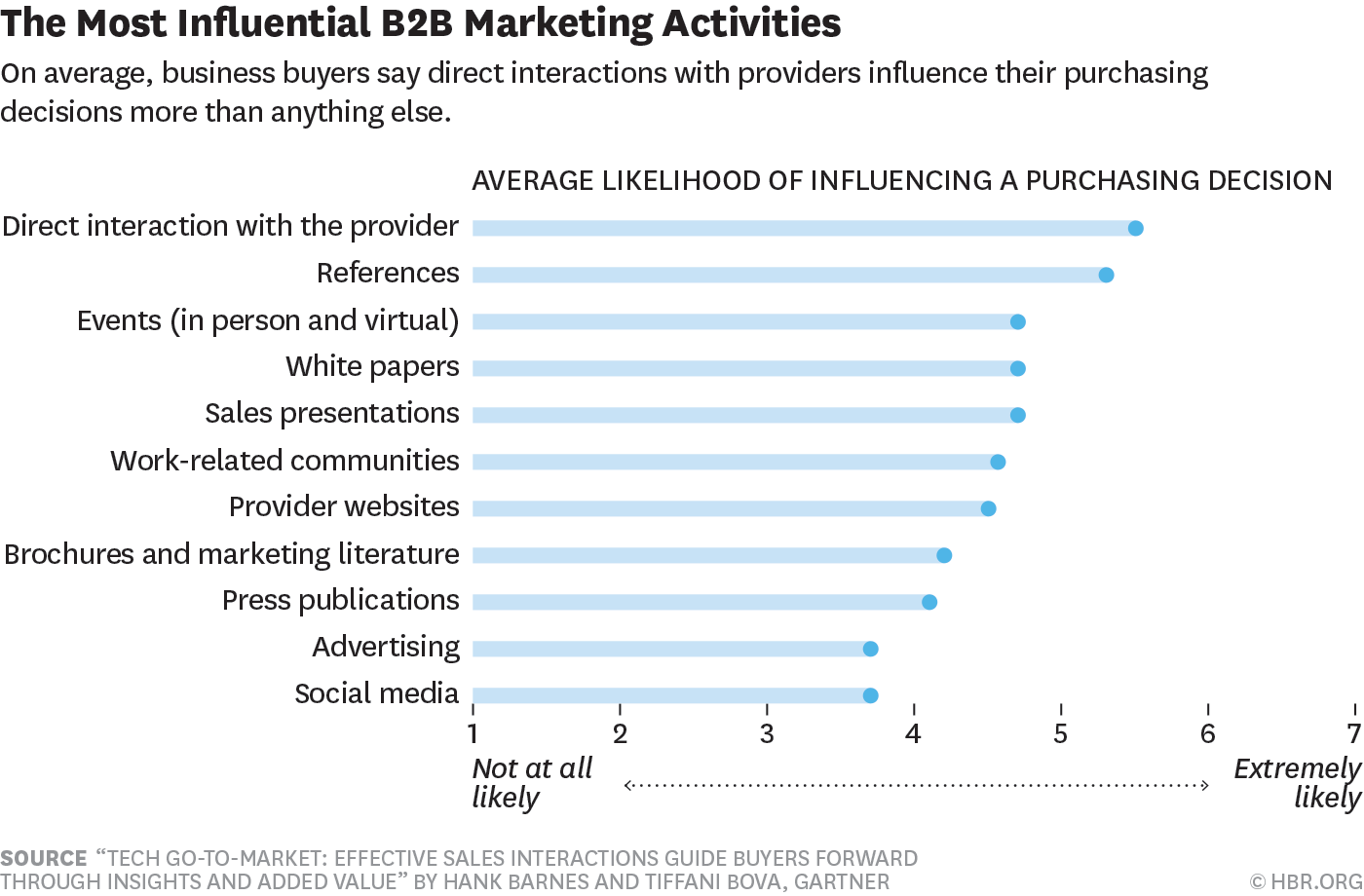by: Frank V. Cespedes & Tiffani Bova
Selling has always been more about the buyer than the seller. So any effective sales model must adapt to changing buying protocols, not ignore or resist them. This is a big transition for firms whose marketing, sales-training and enablement tools, and wider organizational processes reflect outdated assumptions about purchasing in their markets.
For a century, buying has been framed in terms of moving a prospect from Awareness to Interest to Desire to Action (AIDA). The AIDA model and its variants are the basis for sales funnels at many B2B firms. The typical funnel starts with a marketing-generated lead for a “suspect” that, after qualification, becomes a “prospect,” and then a customer through steps that are measured and managed. In each step, sales people are expected to perform a series of tasks, usually sequentially, in order to close. It’s an inside-out process and CRM systems are there to provide data about progression (or not) through that company’s funnel steps — the famous “pipeline” metrics that dominate so much talk about sales.
But Gartner research (see here and here) indicates a very different contemporary buying reality. Rather than moving sequentially through a funnel, buyers actually work through four parallel streams to make a purchase decision.
Let’s examine these activities, one by one:
- Explore: Here, buyers identify a need or opportunity and begin looking for ways to address it, usually via interactions with vendors and self-directed information search on the internet.
- Evaluate: Buyers take a closer look at options uncovered while exploring, again leaning heavily on self-directed search and peer interactions as well as vendor sales representatives.
- Engage: Buyers initiate further contact with providers (or accept proposals from providers) to get help in moving toward a purchase decision.
- Experience: Buyers use a solution, increasingly in pilots or proof of concepts, and develop perceptions about its value based on that usage.
With these changes in mind, understanding where customers are, and how to interact with them appropriately in a given stream, are now central to effective selling.
Here are a few tips and insights to help you navigate these shifts.
The sales force is more important than ever. Regardless of which path customers take, or in which order they take them, they want to deal with people who can help them move toward a purchase decision, be the internal champion at the vendor, and bring it together for that customer. In fact, B2B buyers report that, compared to other sources of information, these interactions are the most influential in their decision making process:

The source considered the least influential is social media. Don’t believe the hype. Sales people have not been replaced by digital, and providing relevant solutions remains key in most B2B buying scenarios.
One reason why the sales force remains so important to the B2B customer is that most products and services sold to business organizations are components in a wider usage system at that buyer, and customer value ultimately resides in that usage, not just the individual product.
To add to that, business buyers must justify a decision to others in the organization, especially as capital expenditures flow less liberally in many industries since the financial crisis of 2008. And you are naïve or spending too much time on your smartphone if you believe that a combination of economics, solution identification, product application, risk management, and political journey through the buyer’s organization is now handled predominately online in most buying scenarios and without knowledgeable and savvy sales help.
The research also found that, across all buying streams, buyers emphasized that interactions with sellers — technical demonstrations, sales presentations tailored to my company’s need – should be about the buyer’s needs. Among the least valued interactions are sales calls in response to registering for webinars or events. That is, core solution-selling and account-management skills still matter.
Lastly, although buyers certainly use online search, they use it as a complement to, not a substitute for, interactions with sales reps, channel partners, and others at their suppliers. If anything, access to information online has increased awareness that relevant alternatives and best practices about product applications and service requirements often reside outside one’s firm. In turn, this drives the B2B buyer’s propensity to seek information from vendors who work with companies across regions or vertical segments, and who can use that knowledge to help frame and deliver solutions for that buyer’s needs.
Buying is a continuous and dynamic process. Specious talk about disintermediation of salespeople obscures the real issues facing firms. Sales people are not disappearing, but buying processes and therefore sales tasks are changing.
For example, note that in the second figure above customer references are a close second in terms of influence, and the nature of references has changed. In the past, a buyer might ask for references and that seller would cite a few satisfied customers. But through the web, customers connect with each other and get unedited versions of others’ experience through review sites such as bazaarvoice and PowerReviews, and they gain access to thousands of people at other companies who can share experiences and options through community sites such as SAP Developer Network and Marketo Marketing Nation.
Also playing important roles are events, white papers, and the seller’s website — activities that are typically part of marketing’s domain, not sales. This puts pressure on a notoriously fraught relationship: improving coordination between sales and marketing, two functions that are increasingly interdependent but different in their perspectives and procedures. The marketing–sales relationship now tops the agenda of concerns in a survey of B2B executives.
More generally, it’s important to recognize that web sites, blogs, and other digital media have made vendor organizations more visible and transparent to potential buyers, which has disrupted the inside-out funnel approach. Prospects now touch your brand and company at many different points (online, offline, marketing collateral, and so on), when they want, and each touch has an impact on selling tasks. Buyers value interaction with others at your firm besides the sales person (e.g., product specialists, technical experts, professional services personnel, delivery personnel, pre- and post-sales applications resources). In their buying streams, they expect the rep to orchestrate those interactions purposefully, and efficient coordination of these interaction points must be reflected in an effective 21st-century go-to-market strategy.
Finally, if you consider the streams that now characterize B2B buying and what buyers value in their suppliers’ behaviors, a big disconnect becomes apparent. Despite huge advances in technology over the past two decades, most sales models and performance practices are the ad-hoc accumulation of years of reactive decisions, often by different managers pursuing different goals. This is why many B2B sales models firms are incapable of dealing with the reality that buying is now continuous and dynamic — an on-going movie, not a selfie or snapshot in a funnel.
Choices are often false. Despite what you often hear, no single tactic — e.g., a given selling methodology, “challenging” the customer, or more “big data” analytics — will address the new reality. Aligning buying and selling is a process, not a one-shot deal.
Going forward, many B2B sellers will need to reconfigure their selling processes more effectively and efficiently for each buying stream. They should not waste lots of time and energy debating whether to be online or in-person, interacting via the web or through sales reps, digital or human. They need to do both, and create the right mix for their go-to-market programs.
It’s also important that every group within an organization that deals with customers has a shared vision of how customers buy and, more importantly, a clear sense of their company’s strategy. The cross-functional communication and coordination that is required to navigate this change is the job of leadership. Is your organization, not just your sales force, ready to deal with this purchasing reality?
Finally, to paraphrase Churchill, it is not “the end of solution sales” and it’s not the beginning of the end. But it should be the end of glib generalizations about sales and selling, which remain complex, changing, and people-dependent activities in most B2B markets. As a leader, understanding how buying really works is the place to start in order to spur effective selling, profitable growth, and better resource allocations in your firm.






